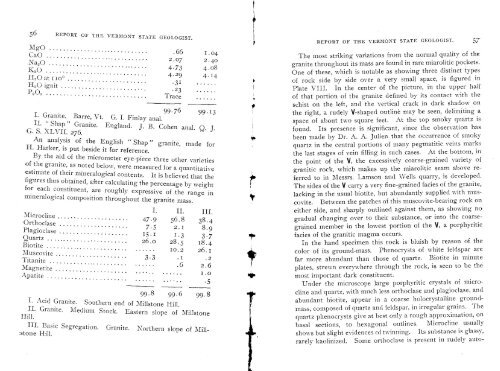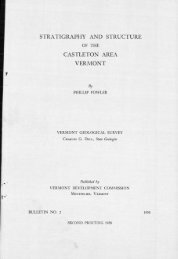Mineral Industries and Geology of Certain Areas - Vermont Agency ...
Mineral Industries and Geology of Certain Areas - Vermont Agency ...
Mineral Industries and Geology of Certain Areas - Vermont Agency ...
You also want an ePaper? Increase the reach of your titles
YUMPU automatically turns print PDFs into web optimized ePapers that Google loves.
56<br />
REPORT OF THE VERMONT STATE GEOLOGIST.<br />
MgO.............................<br />
CaO<br />
.66 104<br />
.............................. 2.07 2.40<br />
Na20...............................<br />
K20 7 4.08<br />
.............................. 4.29<br />
1.-I0 at 1100<br />
4.14<br />
.<br />
.31<br />
H 20 ignit ..........................23<br />
P20 ............. ................ Trace<br />
99.13<br />
I. Granite. Barre, Vt. G. I. Finlay anal. 99.76<br />
II. "Shap" Granite. Engl<strong>and</strong>. J. B. Cohen anal. Q. J.<br />
G. S. XLVII. 276.<br />
An analysis <strong>of</strong> the English "Shap" granite, made for<br />
H. Harker, is put beside it for reference.<br />
By the aid <strong>of</strong> the micrometer eye-piece three other varieties<br />
<strong>of</strong> the granite, as noted below, were measured for a quantitative<br />
estimate <strong>of</strong> their mineralogical contents. It is believed that the<br />
figures thus obtained, after calculating the percentage by weight<br />
for each constituent, are roughly expressive <strong>of</strong> the range in<br />
mineralogical composition throughout the granite mass.<br />
I II III.<br />
Microcijue .....................<br />
47.9<br />
Orthoclase 56.8 ...... 38.4<br />
..............<br />
Plagioclase<br />
7 - 5 2.1 8.9<br />
.................... I 5<br />
Quartz<br />
.3<br />
........................<br />
3 .7<br />
26.0 28.5<br />
Biotjte<br />
18.4<br />
.............................10.2<br />
i\Iuscovjte<br />
26.1<br />
.....................<br />
3.3 . I<br />
Titanite<br />
.2<br />
........................... .6<br />
Magnetite<br />
2.6<br />
............................ .<br />
.0<br />
Apatite ....................................5<br />
99.8 99.6 99.8<br />
I. Acid Granite Southern end <strong>of</strong> Millstone Hill.<br />
II. Granite. Medium Stock. Eastern slope <strong>of</strong> Millstone<br />
Hill.<br />
III. Basic Segregation. Granite. Northern slope <strong>of</strong> Mill-<br />
:stone Hill.<br />
REPORT OF THE VERMONT STATE GEOLOGIST. 57<br />
The most striking variations from the normal quality <strong>of</strong> the<br />
granite throughout its mass are found in rare miarolitic pockets.<br />
One <strong>of</strong> these, which is notable as showing three distinct types<br />
<strong>of</strong> rock side by side over a very small space, is figured in<br />
Plate VIII. In the center <strong>of</strong> the picture, in the upper half<br />
<strong>of</strong> that portion <strong>of</strong> the granite defined by its contact with the<br />
schist on the left, <strong>and</strong> the vertical crack in dark shadow, on<br />
the right, a rudely V-shaped outline may be seen, delimiting a<br />
space <strong>of</strong> about two square feet. At the top smoky quartz is<br />
found. Its presence is significant, since the observation has<br />
been made by Dr. A. A. Julien that the occurrence <strong>of</strong> smoky<br />
quartz in the central portions <strong>of</strong> many pegmatitic veins marks<br />
the last stages <strong>of</strong> vein filling in such cases. At the bottom, in<br />
the point <strong>of</strong> the V, the excessively coarse-grained variety <strong>of</strong><br />
granitic rock, which makes up the miarolitic seam above referred<br />
to in Messrs. Lamson <strong>and</strong> \Vells quarry, is developed.<br />
The sides <strong>of</strong> the V carry a very fine-grained facies <strong>of</strong> the granite,<br />
lacking in the usual biotite, but abundantly supplied with muscovite.<br />
Between the patches <strong>of</strong> this muscovite-bearing rock on<br />
either side, <strong>and</strong> sharply outlined against them, as showing no<br />
gradual changing over to their substance, or into the coarsegrained<br />
member in the lowest portion <strong>of</strong> the V, a porphyritic<br />
facies <strong>of</strong> the granitic magma occurs.<br />
In the h<strong>and</strong> specimen this rock is bluish by reason <strong>of</strong> the<br />
color <strong>of</strong> its ground-mass. Phenocrysts <strong>of</strong> white feldspar are<br />
far more abundant than those <strong>of</strong> quartz. Biotite in minute<br />
plates, strewn everywhere through the rock, is seen to he the<br />
most important dark constituent.<br />
Under the microscope large porphyritic crystals <strong>of</strong> microdine<br />
<strong>and</strong> quartz, with much less orthoclase <strong>and</strong> plagioclase, <strong>and</strong><br />
abundant biotite, appear in a coarse holocrystalline groundmass,<br />
composed <strong>of</strong> quartz <strong>and</strong> feldspar, in irregular grains. The<br />
quartz phenocrysts give at best only a rough approximation, on<br />
basal sections, to hexagonal outlines. Microcline usually<br />
shows but slight evidences <strong>of</strong> twinning. Its substance is glassy,<br />
rarely kaolinized. Some orthoclase is present in rudely auto-













